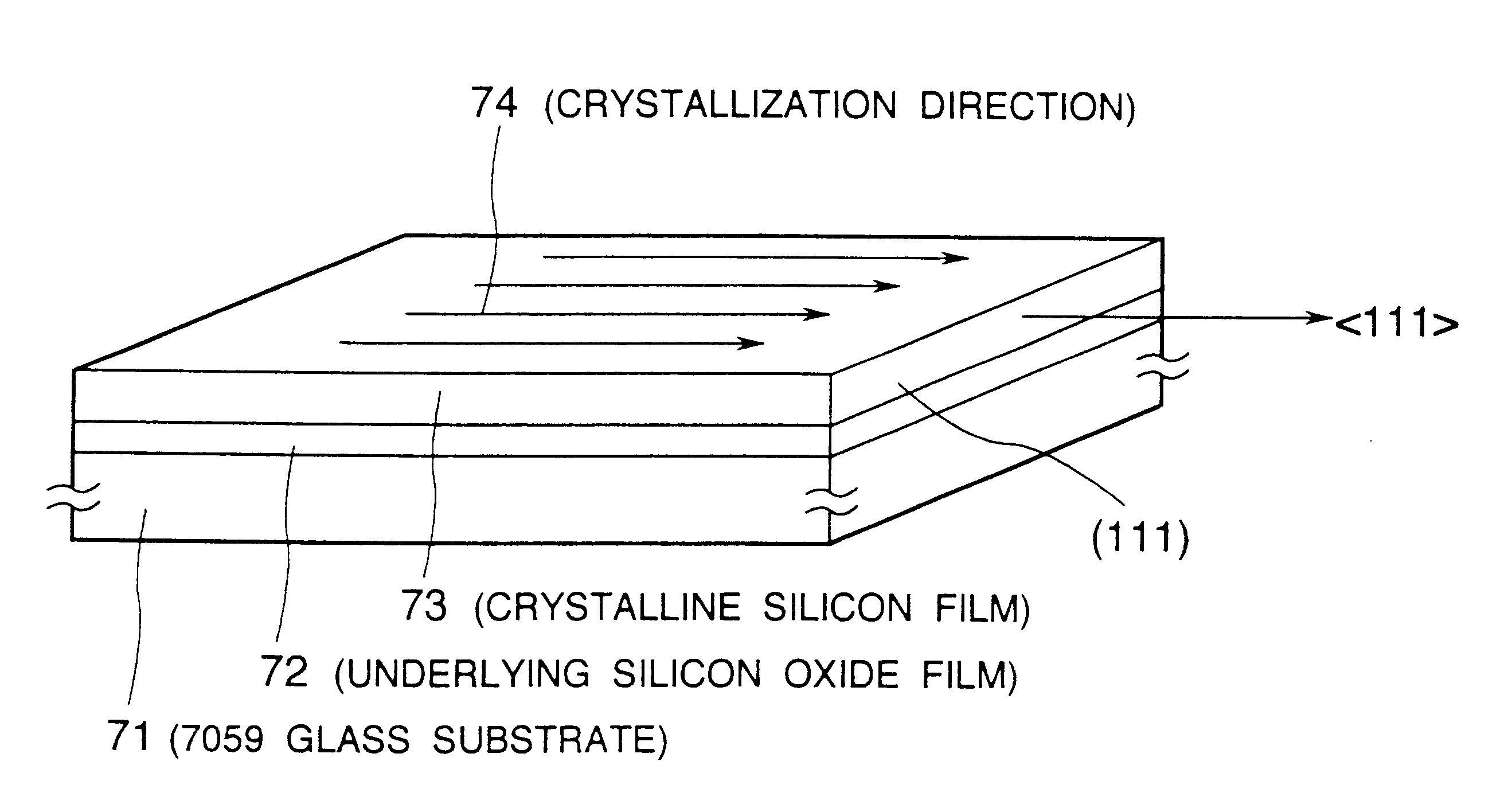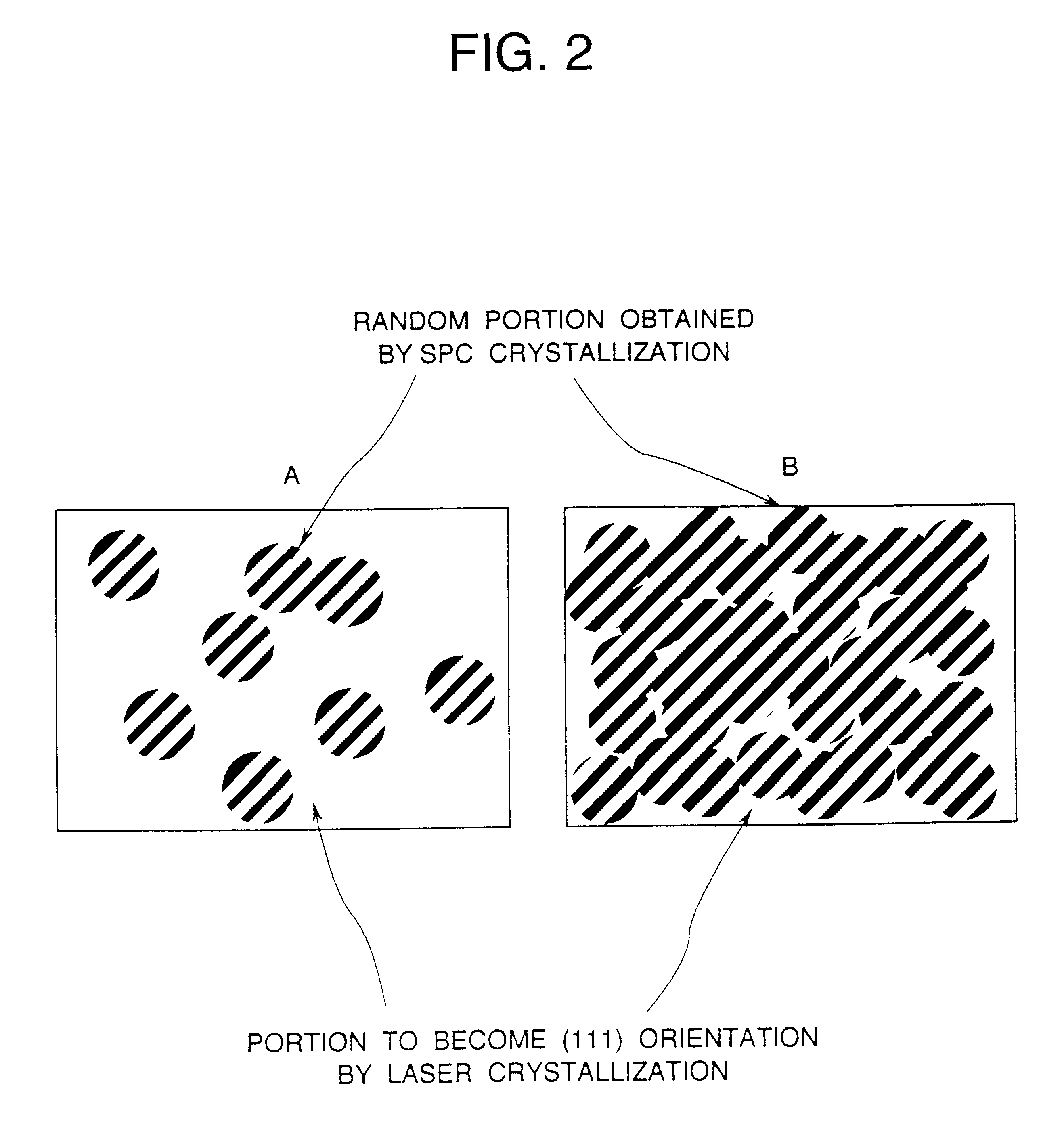Method of preparing a semiconductor having controlled crystal orientation
a technology of controlled crystal orientation and semiconductor, which is applied in the direction of semiconductor devices, electrical devices, transistors, etc., can solve the problems of reducing the reliability and electrical stability of a device using such a semiconductor, adversely affecting the properties of the device, and introducing nickel that is not sufficiently useful
- Summary
- Abstract
- Description
- Claims
- Application Information
AI Technical Summary
Benefits of technology
Problems solved by technology
Method used
Image
Examples
example 1
This example illustrates the preparation of a silicon film with a high (111) orientation which involves selective provision of a 1200 .ANG. silicon oxide film which is used as a mask for selective introduction of nickel and lateral growth.
The preparation process in this example is outlined in FIG. 3. First, on an amorphous silicon film (a 500 .ANG. film prepared by plasma CVD) placed on a glass substrate (Corning 7059, 10 cm square) there is formed a silicon oxide film 21 which functions as a mask (silicon dioxide cover) to a thickness of 1000 .ANG. or more, 1200 .ANG. in this example. The inventors have experimentally confirmed that a thickness of the silicon dioxide film 21 exceeding 500 .ANG. does not cause any particular trouble, and it is believed that thinner films may be accepted as long as they have fine quality.
The silicon oxide film 21 is then patterned as desired by a conventional photolithographical patterning process. Thereafter irradiation with ultraviolet ray is condu...
example 2
This Example is for a case where entirely the same process as in Example 1 was used, varying only the thickness of the amorphous silicon film to two levels, 400 .ANG. and 800 .ANG..
The results revealed that the (111) orientation ratio obtained with X-ray diffraction for the 400 .ANG. specimen was about 1.0, showing it to be an almost completely (111)-oriented film, while that of the 800 .ANG. specimen was 0.720, or somewhat less (111) orientation as compared with the 500 .ANG. sample.
example 3
This example is for a case where a crystallization-facilitating catalytic element is contained in an aqueous solution which is then applied on an amorphous film, which is then subjected to heat for crystallization followed by irradiation with laser light for further improvement of the crystallinity. This case corresponds to the vertical growth in the previous description, and may provide a film with a relatively random orientation.
The process as far as the introduction of a catalytic element (in this case, nickel was used) will be explained with reference to FIG. 5. In this example, Corning 7059 glass is employed as the substrate 11. Its size is 100 mm.times.100 mm.
First, the amorphous silicon film 12 is formed to 100 to 1500 .ANG. by plasma CVD or LPCVD. In this particular case, the amorphous silicon film 12 is formed to a thickness of 500 .ANG. by plasma CVD (FIG. 5(A)).
Then, to remove the dirt and spontaneous oxide film, treatment with hydrofluoric acid is carried out, after whic...
PUM
| Property | Measurement | Unit |
|---|---|---|
| temperatures | aaaaa | aaaaa |
| temperatures | aaaaa | aaaaa |
| temperature | aaaaa | aaaaa |
Abstract
Description
Claims
Application Information
 Login to View More
Login to View More - R&D
- Intellectual Property
- Life Sciences
- Materials
- Tech Scout
- Unparalleled Data Quality
- Higher Quality Content
- 60% Fewer Hallucinations
Browse by: Latest US Patents, China's latest patents, Technical Efficacy Thesaurus, Application Domain, Technology Topic, Popular Technical Reports.
© 2025 PatSnap. All rights reserved.Legal|Privacy policy|Modern Slavery Act Transparency Statement|Sitemap|About US| Contact US: help@patsnap.com



